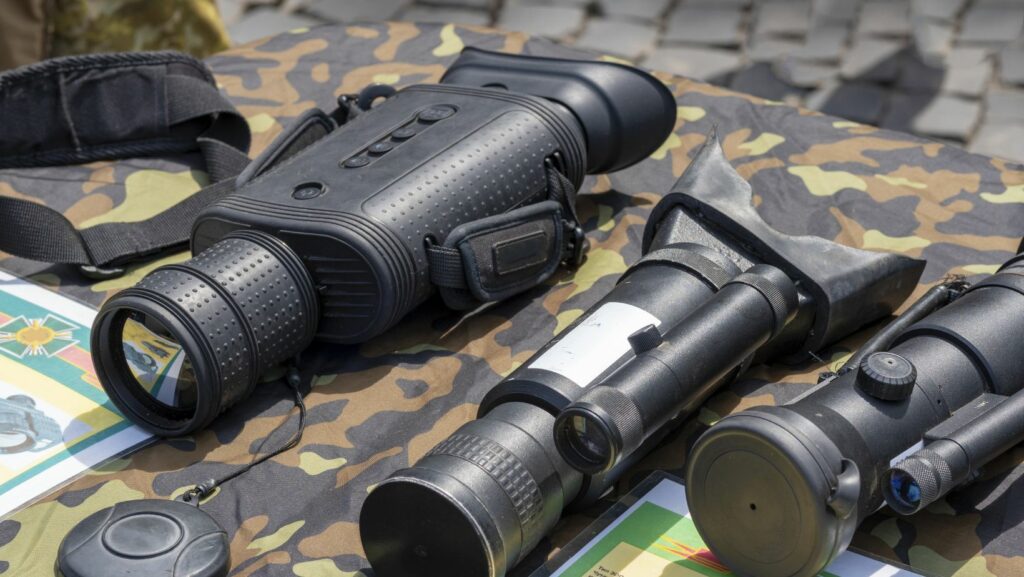Thermal Binoculars. How to Take Care of the Equipment

Thermal binocular technology is an impressive example of modern equipment that allows you to obtain images in conditions of low visibility and bad weather conditions. They find applications in various fields, including military use, search and rescue, medical, police, and public surveillance. In this article, we will examine thermal binoculars and how they work.
Thermal binoculars work based on the principle of thermal vision, which consists of detecting environmental objects’ thermal radiation. The main components of this technology include:
The main component of thermal vision is heat-sensitive materials such as quartz, amorphous selenium, indium antimonide, and liquid crystals. These materials can reflect the thermal radiation of objects in the form of electrical signals.
Thermal binoculars have infrared lenses that focus thermal radiation on heat-sensitive materials. This creates an image based on the temperature difference of the objects.
The received signals are converted into a display on the screen of thermal binoculars. An infrared image is a gradation of colors, where each color corresponds to a certain level of thermal radiation. The warmest objects are displayed as bright light spots, and the coldest – as dark areas.
Use of Thermal Binoculars
Thermal binoculars have a wide range of applications, including:
Military use: They allow military operations to operate in low visibility conditions without significant risk to the lives of military personnel.
Police: Thermal binoculars help law enforcement officers identify suspicious persons and plot optimal routes for investigations and patrols.
Search and rescue: They are used to find lost or injured persons in hard-to-reach places.

Medical: Thermal binoculars help medical personnel diagnose injuries and illnesses more quickly and assess bleeding and inflammation.
Public surveillance: They are used for security and monitoring facilities and territories.
How to Take Care of the Equipment
Thermal binocular technology is essential for improving night vision and navigation in low-visibility conditions. It has applications in various industries, including military, medical, police, search and rescue, and public surveillance. It is essential to properly care for the equipment to ensure a long and efficient working process of thermal binoculars. This article will look at several important aspects of taking care of thermal binoculars and maintaining their effectiveness.
Cleaning and Storage
The first and most crucial step in caring for thermal binoculars is regular cleaning and proper equipment storage. This will help avoid dirt, scratches, and other damage that can affect the quality of the thermal image.
Lens Cleaning
The lenses of thermal binoculars focus on thermal radiation and create an image. Lens cleaning is one of the most important aspects of equipment care. To clean the lenses:
Use a special soft dry cloth or a vacuum cleaner.
Avoid using rough materials that can scratch the lenses.
If necessary, remove dirt or watermarks using special lens cleaners.
Storage
Storage of thermal binoculars is also of great importance. They should be stored in protective covers or cases against dust, moisture, and mechanical damage. In addition, storage of the equipment in conditions of excessive humidity or extreme temperatures should be avoided.
Power Supply and Batteries
Many thermal binoculars operate on batteries, so it is essential to manage the power properly and ensure that the equipment lasts long.
Selection of Batteries
First, make sure you are using the recommended types of batteries listed in the equipment manuals. Using the wrong batteries can cause thermal binoculars to malfunction or even damage them.
Charging Batteries
If your thermal binoculars are equipped with batteries, you should carefully follow the instructions for charging them. Usually, it is recommended to use the chargers that come with the equipment. Avoid overcharging the batteries; do not leave them discharged for long periods.
Battery Storage
If you use thermal binoculars briefly, remove the batteries or accumulators from the equipment to avoid power leakage and possible damage. Store batteries in a dry and cool place.
Protection Against Extreme Conditions
Thermal binoculars can be vulnerable to extreme environmental conditions. Here are some tips for protecting your equipment:
Moisture Protection
Many thermal binoculars are moisture-proof, but you should avoid getting water or moisture into the equipment. Use protective cases or covers that prevent moisture from entering.
Extreme Temperatures
Thermal binoculars can be exposed to extreme temperatures, but the manufacturer’s recommendations for operating temperatures should be followed.

Batteries that can work at low temperatures should be used in icy conditions.
Shocks and Vibrations
Avoid shocks and strong vibrations that can damage the sensitive components of the thermal binoculars. Use sturdy cases or covers for transporting and storing equipment.
Regular Maintenance
Finally, regular maintenance is an essential aspect of thermal binocular care. If technical problems occur, contact specialists or service centers for repair and maintenance.
Thermal binoculars are high-tech devices used in various industries. They work based on thermal radiation, allowing you to get images of insufficient visibility and bad weather conditions. Types of thermal imaging binoculars differ in purpose and functionality, which makes them versatile for solving various tasks. Thermal binoculars are essential in increasing safety and efficiency in multiple fields of activity.
The technology of thermal imaging binoculars makes an invaluable contribution to improving the quality of night vision and navigation in conditions of limited visibility. Proper care of this equipment is necessary for long-term and efficient operation. Lens cleaning, adequate storage, careful use of batteries, protection against extreme conditions, and regular maintenance will help keep the functionality of thermal binoculars high. Following the recommendations, you can enjoy a reliable, high-quality thermal imager for many years.


 Top 10 Cool Phone Accessories to Elevate Your Smartphone Experience in 2023
Top 10 Cool Phone Accessories to Elevate Your Smartphone Experience in 2023  Discover the Latest Electronic Gadgets: Top Innovations for 2023 You Need to Know
Discover the Latest Electronic Gadgets: Top Innovations for 2023 You Need to Know  Discover the Latest Cool New Technology Transforming Our Lives and Industries
Discover the Latest Cool New Technology Transforming Our Lives and Industries  25 Cool Gadgets to Buy in 2023 That Will Enhance Your Everyday Life
25 Cool Gadgets to Buy in 2023 That Will Enhance Your Everyday Life  Top Technology Items Transforming Daily Life and Productivity in 2023
Top Technology Items Transforming Daily Life and Productivity in 2023  Discover the Best Luxury Tech Gadgets for Ultimate Sophistication and Innovation
Discover the Best Luxury Tech Gadgets for Ultimate Sophistication and Innovation